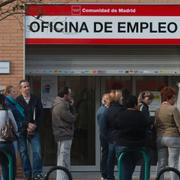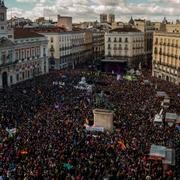
Spanska statsskulden är nu rekordhög
Spaniens statsskuld överskred 100 procent av BNP i juni. Det visar nya siffror från landets centralbank, skriver Reuters.
Landets bruttoskuld nådde därmed rekordhöga 1,1 biljoner euro, motsvarande 10 000 miljarder kronor.
Utvecklingen går på tvärs mot ambitionen och EU-kommissionen begäran att hårt skuldsatta länder bör göra mer för att minska skuldbergen.
bakgrund
Spaniens ekonomi
Wikipedia (en)
Spain has the fourteenth-largest economy by nominal GDP in the world, and it is also among the largest in the world by purchasing power parity. The country is a member of the European Union, the Organization for Economic Co-operation and Development, and the World Trade Organization.
The Spanish economy is the fifth-largest in the European Union, and the fourth-largest in the Eurozone, based on nominal GDP statistics. In 2012, Spain was the twelfth-largest exporter in the world and the sixteenth-largest importer.
Spain is listed 23rd in UN Human Development Index and 30th in GDP (PPP) per capita by the World Bank, thus it is classified as a high income economy and among the countries of very high human development. According to The Economist, Spain has the world's 10th highest quality of life. Spain has also the biggest life expectancy in Europe.
Following the financial crisis of 2007–08, the Spanish economy's plunged into recession, entering a cycle of low macroeconomic performance. Compared to the EU's and US. average, the Spanish economy entered recession later (the economy was still growing by 2008), but stayed there for longer. The economic boom of the 2000s had been reversed, leaving over a quarter of Spain's workforce unemployed by 2012. In aggregated terms, the Spanish GDP contracted by almost 9% during the 2009-2013 period.
The economic situation started improving by 2013-2014. During the boom years, Spain had built up a trade deficit eventually reaching a record amounting to 10% of GDP (2007). Then, during the economic downturn, Spain significantly reduced imports, increased exports and kept attracting growing numbers of tourists; as a result, after three decades of running a trade deficit the country attained in 2013 a trade surplus which has strengthened during 2014 and 2015. Exports in 2014 were 34% of GDP, up from 24% in 2009.
In 2015 the Spanish GDP grew by 3.2%, a rate not seen since 2007, before the crisis struck; such growth rate was the highest among larger EU economies that year. In just two years (2014-2015) the Spanish economy had recovered 85% of the GDP lost during the 2009-2013 recession, which got some international analysts to refer to Spain's current recovery as "the showcase for structural reform efforts".
Omni är politiskt obundna och oberoende. Vi strävar efter att ge fler perspektiv på nyheterna. Har du frågor eller synpunkter kring vår rapportering? Kontakta redaktionen


